Dragon and watch. Strength and time.
It’s not enough for a man just to live and speculate about where his path will lead him tomorrow. He wants to know for sure what lies ahead of him, he has a propensity to believe in all sorts of symbols and signs, pointing the way. Therefore, such a science as astrology today has been extensively developed and is very popular. If previously the so-called western zodiac horoscope, which was used to accurately describe a psycho-type, came to the fore, now you can feel a great influence of the East, and the Chinese horoscope with its animal characters seeps into the attributes and style of living and thinking of people all over the world today. Each new year, we decorate our apartments with various figures, pictures and other things with symbols of the year. The watches have also experienced the influence of powerful animal symbols of the Eastern horoscope, especially in 2012 - the year that is ruled by one of the most amazing, strong, majestic and mysterious creatures - Dragon.
Oriental calendar
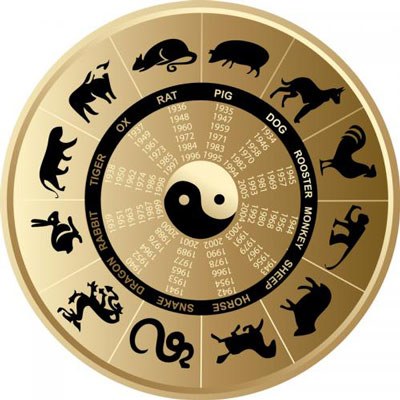 The Eastern countries use the lunar calendar, according to which the new year comes in the first new moon after the 21st of January in the sign of Aquarius, in which the Sun enters at 20 or 21 of January and ends at 18 of February. Thus, every year the date of new year coming by the oriental calendar ranges from January 21 to February 20. When it comes to the oriental horoscope, you often have in mind the Chinese horoscope, but the Japanese "animal calendar" may be also implied. According to some sources, it came to Japan from China indeed. Since then, the Japanese relied on it until the 70s of the XIX century. You might have noticed that I use the words "horoscope" and "calendar" as synonyms. Let me explain that the word "horoscope" is derived from the Greek term which means "time" or "period". The Eastern countries use the lunar calendar, according to which the new year comes in the first new moon after the 21st of January in the sign of Aquarius, in which the Sun enters at 20 or 21 of January and ends at 18 of February. Thus, every year the date of new year coming by the oriental calendar ranges from January 21 to February 20. When it comes to the oriental horoscope, you often have in mind the Chinese horoscope, but the Japanese "animal calendar" may be also implied. According to some sources, it came to Japan from China indeed. Since then, the Japanese relied on it until the 70s of the XIX century. You might have noticed that I use the words "horoscope" and "calendar" as synonyms. Let me explain that the word "horoscope" is derived from the Greek term which means "time" or "period".
Anyone, who knows even a little in astrology, has noticed that the Chinese horoscope has some connection with the Western zodiac signs, its cycle is also divided into 12 parts, related to some animal or other unusual creature. However, the Chinese Zodiac is divided by years, not months as the West one, and the animals are completely unrelated to the constellations. The Eastern horoscope is based on the movements of the Sun and Moon, and it uses two cycles of the planets in the Solar System: Jupiter and Saturn. The above planets were not chosen by chance, since, as the astronomers proved, the Sun has a huge impact on the development of human spirit, the Moon – on the physical development, Jupiter governs the behavior of people in society, and under the influence of Saturn individual characteristics of each person are formed.
Another interesting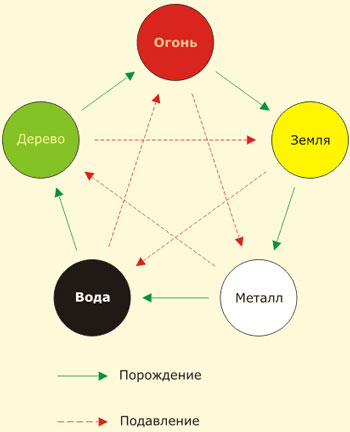 feature of the Eastern horoscope is elements, of which, as the ancient Chinese people believed, the whole world, all beings and things consisted. These are five elements: Wood, Fire, Earth, Metal and Water. That is the sequence, in which they follow each other. Moreover, each element is linked with a specific color, which "paints" an animal of a particular year. Thus, the element of fire is protected by red color, the element of earth - yellow or brown (ocher), wood - blue-green, water - black (sometimes blue), metal - white. As for me, a question immediately suggested itself: why do the ancient Chinese people imagined the water in black? As it is an unusually bright and wonderful 'substance', which for centuries people have been treating with awe and reverence. After a brief search in the depths of almighty Internet, I realized that in Chinese culture the black is not a color of mourning and grief, as in the West, but a color of good and bright future, in which they "painted" the Water. feature of the Eastern horoscope is elements, of which, as the ancient Chinese people believed, the whole world, all beings and things consisted. These are five elements: Wood, Fire, Earth, Metal and Water. That is the sequence, in which they follow each other. Moreover, each element is linked with a specific color, which "paints" an animal of a particular year. Thus, the element of fire is protected by red color, the element of earth - yellow or brown (ocher), wood - blue-green, water - black (sometimes blue), metal - white. As for me, a question immediately suggested itself: why do the ancient Chinese people imagined the water in black? As it is an unusually bright and wonderful 'substance', which for centuries people have been treating with awe and reverence. After a brief search in the depths of almighty Internet, I realized that in Chinese culture the black is not a color of mourning and grief, as in the West, but a color of good and bright future, in which they "painted" the Water.
We return to the horoscope. In the eastern calendar two years following each other have the same color, just different shades. The first year is masculine or Yang (vector of expansion), and its "pair" - feminine or Yin (vector of compression). Masculine is as usual more strong and active, while feminine is much softer. For example, if the current year is the Year of Ox, then in 12 years the cow will rule. In addition, the researchers claim that people in the year of Yang is activated, shows high activity, reaches great heights, and in the year of Yin uses accumulated forces and finishes once started works. By the way, the division by the principle of Yin-Yang is totally different in Japan and China, and therein the fundamental difference between two horoscopes lies.
So, 12 animals and 5 elements. Multiply these two numbers and get the result: one cycle of the eastern calendar, beginning with the Year of Wood Rat and ending with the Year of Water Pig, makes up 60 years. The new 60-year cycle began in February 2, 1984; the animals are repeated every 12 years, and the elements - every 10 years (five colors by two shades). The number of animals of the eastern horoscope – 12 – also arouses special interest. According to astronomers, the number “12” is associated with Jupiter, which on the move on orbit around the Sun makes a full circle within 12 years. There are also extremely interesting legends on the sequence of animals replacing each other, but that's another topic for discussion.
Legends about animals or how to please the Lord
All creatures, phenomenon or objects on the Earth are based on a beautiful (or even ugly) legend. Often people trust a legend more, than a history, so the myth always takes precedence over the history. I would explain this by saying that the legend is a lie that deserves respect and is inherent to very respectable age. At the heart of the eastern horoscope there are extremely interesting legends, the most common of which is the following.
First Legend
Before his death, the great Buddha called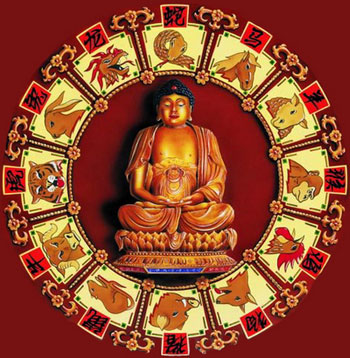 all animals inhabiting the Earth to say goodbye to them. However, only 12 animals responded the call of the master. They are, how we can guess, clever Rat, hardworking Ox, brave Tiger, soft Rabbit, mighty Dragon, wise Serpent, graceful Horse, artistic Goat, clever Monkey, bright Rooster, faithful Dog. Some of them might have pursued a certain goal, hoping that they would get something from dying Buddha, and others came simply "for the goodness of their heart." The latest at the Sacred meadow was the run-out-of-breath Pig. It was late, but it did not shy about that at all. As a token of gratitude, Buddha gave each of the animals came to say goodbye to him a year of reign. And the order of reign was determined by Buddha according to the appearance of animals before him. all animals inhabiting the Earth to say goodbye to them. However, only 12 animals responded the call of the master. They are, how we can guess, clever Rat, hardworking Ox, brave Tiger, soft Rabbit, mighty Dragon, wise Serpent, graceful Horse, artistic Goat, clever Monkey, bright Rooster, faithful Dog. Some of them might have pursued a certain goal, hoping that they would get something from dying Buddha, and others came simply "for the goodness of their heart." The latest at the Sacred meadow was the run-out-of-breath Pig. It was late, but it did not shy about that at all. As a token of gratitude, Buddha gave each of the animals came to say goodbye to him a year of reign. And the order of reign was determined by Buddha according to the appearance of animals before him.
Second legend
The legend number two does not tell about such tragic circumstances of Buddha meeting with twelve animals, but on the contrary, about a rather joyous event - celebrating the New Year. The Buddha invited all the animals that inhabited the planet to visit on holiday, before saying that the one who came to congratulate him first, he would present a year of reign and name that year after the animal. As it turned out, the Rat was the most punctual (or cunning) and came in first, then the Ox arrived, and then other animals "caught up" with the rest in the following order: Tiger, Cat, Dragon, Snake, Horse, Goat, Monkey, Rooster and Dog. Note that this legend also tells about Pig as not very responsive animal that came twelfth. However, the Buddha awarded all 12 animals a year in possession. Each animal transferred to the year its typical qualities and character traits. Moreover, according to some sources, that didn’t happen of their own accord, that was the Buddha’s will, and the animals had no choice but to obey the master.
Third legend
(1).jpg) The third legend is my favorite one. It tells about the Jade Emperor, who was the supreme deity of the Taoistic pantheon (Pantheon - a group of gods who belong to one religion/mythology or a sacred building of the gods) and lived high in the heavens. Once, having a fit of generosity, the emperor decided to choose 12 animals in the world and to instruct each of them to rule one of 12 years, but he kept his idea in secret for the time. Despite the fact that the Jade Emperor was all-powerful ruler, he never descended to the Earth and saw creatures that inhabited it. So, before bestowing the selected animals, he asked his chief adviser to choose the best animals, which were not only beautiful but also useful for people. Since the Jade Emperor was an incredibly busy "man", he didn’t have time for "audience" with all the wildlife of the Planet. The third legend is my favorite one. It tells about the Jade Emperor, who was the supreme deity of the Taoistic pantheon (Pantheon - a group of gods who belong to one religion/mythology or a sacred building of the gods) and lived high in the heavens. Once, having a fit of generosity, the emperor decided to choose 12 animals in the world and to instruct each of them to rule one of 12 years, but he kept his idea in secret for the time. Despite the fact that the Jade Emperor was all-powerful ruler, he never descended to the Earth and saw creatures that inhabited it. So, before bestowing the selected animals, he asked his chief adviser to choose the best animals, which were not only beautiful but also useful for people. Since the Jade Emperor was an incredibly busy "man", he didn’t have time for "audience" with all the wildlife of the Planet.
Thus, the counselor had a difficult task - to choose only 12 animals from a huge variety of terrestrial fauna. First, he called the Rat, which he asked to hand the invitation to its best friend too – the Cat. The Cat was very happy, but unfortunately, it was incredibly lazy and liked to sleep, and asked the Rat to wake it up in time. Another 10 animals well-known to us also received the "Invitation Cards": Ox, Tiger, Rabbit, Dragon, Snake, Horse, Goat, Monkey, Rooster and Dog. As one of the most cunning of animals, the Rat quickly realized that the Jade Emperor convened guests for a reason, so they had to please him, and its friend, the Cat, was better in everything: it was handsome, and its fur was fluffy and glossy. The solution came by itself - it couldn’t wake up the Cat!
So, in the morning all the animals, except the Cat, appeared before the emperor. However, the master noticed that there were only 11 animals, and sent a servant to bring any animal, which would fall first on his way. And the Pig turned to be lucky - it was the animal the servant first saw when he came down to the ground. Meanwhile, the Rat, afraid of being unnoticed, jumped on the back of Ox and began to play the flute to amuse the emperor. And I must say, it worked. The Jade Emperor gave the Rat the first place, the Ox - the second for its generosity, because it allowed the Rat to sit on its back, the Tiger - the third for its beautiful and courageous look, the Rabbit - the fourth for his white fluffy fur. For its magical and unusual appearance the Dragon, which then did not suspect that it would adorn the modern wrist watches and other items, got the fifth place, the Serpent was awarded the sixth place for its wisdom, the Horse - the seventh for the grace and elegance, the Goat - the eighth for powerful horns, the nimble Monkey got the ninth place, the Rooster - the tenth for a bright color, and the faithful and vigilant Dog – the eleventh. The pig, which was perhaps not as attractive and interesting as all other animals, still received the honorary twelfth place.
The Cat, woken up too late, ran into the palace at the last moment, when the ceremony was over, it missed its chance. Assessing the situation, the angry Cat knew what the cause of its misery was, and threw itself on the Rat with the intent to kill it for not waking it up. So the Cat still hates the Rat, which is its worst enemy. By the way, sometimes the Year of Rabbit is called the Year of Cat or Cat/Rabbit, which is somewhat contrary to the above legend. The fact is that in different countries the animals are slightly different. Thus, there is no Year of Rabbit in Vietnam, but there is the Year of Cat.
In addition to the above legends, there are others. According to one of them, all 12 animals were called by the Rat, which fulfilled the order of the emperor, and in another variant all animals had to show their physical abilities in running and swimming competitions. Howbeit, 12 top animals were chosen. And here they are – just like we see them now.
"Signs-animals"
According to the great horoscope of the East, each of the eastern zodiac system animals has a positive, neutral and negative element. No matter which animal is at the head of the year, this period is characterized by its own element, constantly reminding of itself and creating successful and unsuccessful combinations of events. This means that for a man the year "of his animal" (in which year he was born) is not always the most favorable because of strong influence of each of five elements. Another interesting point is the following: the Chinese horoscope is based not on the events, but on the relationships between people. From the point of ancient Chinese philosophers’ view, the relationships between people are the determining factors of the events that happen in our lives.
Rat or Mouse. It's quite a controversial character because in different cultures the rats are treated differently. In East and South Asia the temples and monuments are erected after the rats in order to appease the demons that send people diseases associated with rodents. In Japan, the rats accompany the God of Happiness, and therefore, people treat them appropriately. The Chinese people associate greed and avarice with the rat. Thus, the positive qualities of the Rat are diligence and insight, the negative - mendacity and ruthlessness.
The Ox has been considered as a sacred animal since ancient times, it was depicted on cave paintings. It is a symbol of male power and vitality. The positive qualities of this "sign-animal" are determination and reliability, the negative - short temper and stubbornness.
The Tiger is one of the best signs of Chinese horoscope. It is a symbol of the Earth power and the protection of human life. They had a sovereign fear of the tiger and deep respect. Its features are courage and sincerity, but at the same time, the aggressiveness and recklessness are not alien to it.
Rabbit (Cat). This is an interesting case, when one and the same year is rules by two animals. This is explained by the fact that both animals have a unique ability - to get up on all four pads with no injuries when fallen. Also these animals are always treated with certain distrust, they are often associated with evil spirits (especially the Cat). The Rabbit pros are courtesy and caution, the cons - selfishness and superficiality.
The Snake in Christian countries is treated negatively, while in the East the Snake is respected, appreciated for its wisdom and insight. In the ancient times, the Snake was considered to be a symbol of healing power and fertility. So, the Snake is smart and strong, but sometimes false and cold.
The ancient people were afraid of the Horse, considering it an envoy of underworld, and that animal was sacrificed to the dead. But over the time, the Horse became a good and close friend of man. However, in the East they still treat it with superstitious respect. The positive features of the Horse are intelligence and openness, the negative - infantilism and rudeness.
In Japan, the eighth animal of horoscope is the Sheep, and in China – the Goat. There are no special cult of this animal, the only ceremony, held in ancient times, is embalming of goats as sacred animals. In the East, the animal was a symbol of poor people, but it was very much appreciated. The positive features of the Goat are compassion and generosity, and the negative - pessimism and indecision.
The Monkey, as well as many other animals of horoscope, is treated differently in different countries. Previously, it was a symbol of darkness and destruction. In China, the Monkey is considered to be a defender of man, bringing health and success. The positive features of this "sign-animal" are resourcefulness and sociability, the negative - unreasonable pathos and suspicion.
The Rooster is an unusual bright animal, which, thanks to its red color, was associated by ancient people with the original form of the Sun, and protected from fire. The white Rooster, in its turn, protected from evil spirits. The positive features of Rooster are neatness and responsibility, and the negative - pride and idle talk.
The Dog was referred in mythology as the ancestor of man, and people were often depicted with canine heads. The Chinese people respect the dog, considering it their defender. In Japan, the Dog is regarded as a faithful guardian and servant. The Dog is honest and fair, but it is also cynical and nonsensical.
According to Christianity, the Pig is an unclean animal, embodying greed and lust. In the East, the Pig (Boar) is also considered to be a dirty animal, but if it is tamed, then it becomes a symbol of fertility, prosperity, and virility. By the way, in Northern Thailand, this "sign-animal" is replaced by the Elephant. The Pig pros are sincerity and patience, and the cons - practicality and naivety.
The attentive reader will certainly notice that the above list has a significant gap. The fifth sign, which represents one of the most mysterious and intimidating animals - Dragon, the only mythical creature of the eastern horoscope, is absent. This is an incredibly controversial beast with menacing look, unlimited power and strength, but with a subtle and mysterious "soul."
Dragon: Good and Evil
The creature, which decorates with modern.jpg) watches, is actually a collective name that combines several fabulous and mythological characters. The word "dragon" is often used in the names of real species of vertebrates such as reptiles and fishes. The horoscope is one of the areas where the Dragon is used. This creature is also found in astronomy, Feng Shui, the technique of which is euphemistically called a "search for the Dragon, where it is most difficult to find," and fantasy (a genre of fiction). Many sources give the following interpretation of the word "dragon": it is a mythical creature, which is usually portrayed as a huge snake or other reptile endowed with magical abilities. watches, is actually a collective name that combines several fabulous and mythological characters. The word "dragon" is often used in the names of real species of vertebrates such as reptiles and fishes. The horoscope is one of the areas where the Dragon is used. This creature is also found in astronomy, Feng Shui, the technique of which is euphemistically called a "search for the Dragon, where it is most difficult to find," and fantasy (a genre of fiction). Many sources give the following interpretation of the word "dragon": it is a mythical creature, which is usually portrayed as a huge snake or other reptile endowed with magical abilities.
The name "dragon" derives from the Greek word “drakon”, which is translated as "sea fish" or "serpent." The lexical root of the word, “drak” or “derkesthai”, means "to see clearly." The researchers give a literal translation of the word from Latin - "one sees" or "the one, whose glance is fatal." Even based on the name of this creature, it can be concluded that the Dragon is an animal, which has incredible abilities and performance. Special features of the Dragon are ability to fly, fire breathing, presence of several heads (sometimes tails), and, the most interesting, intelligence. The characteristic features of the Dragon vary depending on the culture, depicting it.
Interestingly, the Dragon, appeared or invented in ancient times, is widespread today, having passed a long evolution, and is one of the most popular multicultural realities of our time. Interest in this creature is growing every year, and studies of this character are gaining rapid momentum. That is what has led to the creation of science, known today as dragonografics.
Dragon in Christian symbolism
.jpg) For some Christians the sign of Dragon in Eastern horoscope can be a complete shock, because for centuries Christianity saw the Dragon as an embodiment of Satan, Devil, or Lucifer, so they feared it and kept off. In the Christian symbolism the Dragon (or devil) is a creature, defeated by the archangel Michael, who cast it into the hell, a place of eternal torment. That is why the Dragon is depicted fire-breathing, and its image is inextricably linked with the fire. Sometimes the Dragon is seen as the devil incarnate, the personification of chaos, which can be destroyed only by spiritual and physical strength. Therefore, the victory over the dragon means the victory of light over darkness. Over time, under the influence of other cultures, the image of Dragon for Christians is gradually being rethought, and the value of the character changes. However, Christianity has still a negative attitude toward it. For some Christians the sign of Dragon in Eastern horoscope can be a complete shock, because for centuries Christianity saw the Dragon as an embodiment of Satan, Devil, or Lucifer, so they feared it and kept off. In the Christian symbolism the Dragon (or devil) is a creature, defeated by the archangel Michael, who cast it into the hell, a place of eternal torment. That is why the Dragon is depicted fire-breathing, and its image is inextricably linked with the fire. Sometimes the Dragon is seen as the devil incarnate, the personification of chaos, which can be destroyed only by spiritual and physical strength. Therefore, the victory over the dragon means the victory of light over darkness. Over time, under the influence of other cultures, the image of Dragon for Christians is gradually being rethought, and the value of the character changes. However, Christianity has still a negative attitude toward it.
Here is one example. In October of 2010, in the Bulgarian city of Varna an unusual monument was established – a one-meter height sculpture, depicting two dragons at the source of mineral.jpg) water that was considered to be therapeutic. These are male and female, which hold a golden "egg of knowledge" in their paws. By the way, according to Persian mythology, the "egg of knowledge" represents the Earth, and two dragons are depicted fighting for the egg, that is for the Earth. Returning to the sculpture in Varna, I’ll note that the statue seriously angered the Orthodox Church. According to Orthodox believers, this sculpture is the embodiment of evil, and two Dragons are the devil and the deviless. However, reading the discussions of the statue at many internet forums, I’ve come to the conclusion that Christians are not so outraged by the appearance of Varna Dragons. To my surprise, most estimates are positive. water that was considered to be therapeutic. These are male and female, which hold a golden "egg of knowledge" in their paws. By the way, according to Persian mythology, the "egg of knowledge" represents the Earth, and two dragons are depicted fighting for the egg, that is for the Earth. Returning to the sculpture in Varna, I’ll note that the statue seriously angered the Orthodox Church. According to Orthodox believers, this sculpture is the embodiment of evil, and two Dragons are the devil and the deviless. However, reading the discussions of the statue at many internet forums, I’ve come to the conclusion that Christians are not so outraged by the appearance of Varna Dragons. To my surprise, most estimates are positive.
Getting deeper into the origin of the word "dragon", I faced a very interesting image in the Romanian Orthodox culture, where there is a special character, an embodiment of the devil himself. This is the ruler Vlad III (1431 - 1476 AD), who became known as Vlad Tepes or Vlad Dracula. "Dracula" can be translated as "son of the dragon" or "offspring of the devil." In Romania, the word "dragon" means "devil." According to historians, Vlad received the nickname "Dragon" (Dracula) from his father, who was in the chivalric Order of the Dragon since 1431, founded by Emperor Sigismund. Count Dracula is known as one of the most bloodthirsty and cruel rulers, the stories of his victims terrify any normal person. However, there is a version that the reason to doubt the authenticity of the document, confirming the cruelty of Vlad Dracula, is quite solid. That document is believed to be compiled by the order of the Hungarian king, who sought to exaggerate the blood-thirstiness of the ruler. The image of the vampire, into which, according to legend, Vlad III turned after the death, became incredibly popular in the modern world.
Summarizing all the above, I’ll note that in the Christian Orthodox symbolism the Dragon is nothing but embodiment of evil. In spite of such negative value of the Dragon, in the modern world, perhaps, there is no more popular character, which decorates a variety of subjects of human life, including watches.
Dragon in East Asia
.jpg) The perception of Dragon in East Asia is completely different from its perception in Christianity. The differences are obvious even in the appearance of Dragon: in China, it is depicted with horns, claws, thorns on the ridge and scales. If we talk about an earlier period, the Middle Ages, the Dragons were symbols of anger and betrayal, but at the same time, symbols of leadership and independence. They tried to throw the Dragon-sage down to get its treasures and earn the glory of the winner of the slyest creatures of the world (there is an analogy with the Slavic legends and tales here). The perception of Dragon in East Asia is completely different from its perception in Christianity. The differences are obvious even in the appearance of Dragon: in China, it is depicted with horns, claws, thorns on the ridge and scales. If we talk about an earlier period, the Middle Ages, the Dragons were symbols of anger and betrayal, but at the same time, symbols of leadership and independence. They tried to throw the Dragon-sage down to get its treasures and earn the glory of the winner of the slyest creatures of the world (there is an analogy with the Slavic legends and tales here).
Today, the Dragon in the East is a symbol of happiness, which is able to produce the drink of immortality. Hence the presence of the Dragon among the signs of Eastern horoscope. In China, the Dragon represents the primary element Yang or masculine, sometimes this being is interpreted as a symbol of the nation. The Dragon-Yang is inextricably linked with the primary element of Yin or feminine, which is embodied by Phoenix. That is why the image of Dragon in China has become a symbol of the emperor, and the image of Phoenix - a symbol of the Empress. Speaking of the Dragon in modern Chinese culture in general, this animal is a sign of light, luck, power and greatness, the personification of wisdom and activity, and its indicating character bears the concept of energy and mind.
As the king of all animals, the Chinese Dragon is a symbol of imperial power, such "snake" was often depicted with a human body and the head of the Dragon. There is a Chinese legend that the Yellow Emperor (one of five emperors of China, who is considered to be the ancestor of all Chinese people and the founder of Taoism) turned into a dragon and flew up to heaven at the end of his life. A real Emperor must have a birthmark in the form of Dragon. Under the rule of the Qing Dynasty the majestic Dragon adorned the state flag, and those bold commoners, who dared to wear clothing with images of Dragon, were punished by death. The great importance of this mythical character in the Chinese culture can be traced even in the annual festival, called dragon boats, arranged in honor of the Dragon. This day in China they organize a race on boats, representing the Dragons. Be sure, it's a delightful spectacle that strikes by its solemnity and vivid colors. By the way, in China the Dragon is associated with water, it acts as the Lord of rivers, lakes and seas, but, nevertheless, it can fly. of all Chinese people and the founder of Taoism) turned into a dragon and flew up to heaven at the end of his life. A real Emperor must have a birthmark in the form of Dragon. Under the rule of the Qing Dynasty the majestic Dragon adorned the state flag, and those bold commoners, who dared to wear clothing with images of Dragon, were punished by death. The great importance of this mythical character in the Chinese culture can be traced even in the annual festival, called dragon boats, arranged in honor of the Dragon. This day in China they organize a race on boats, representing the Dragons. Be sure, it's a delightful spectacle that strikes by its solemnity and vivid colors. By the way, in China the Dragon is associated with water, it acts as the Lord of rivers, lakes and seas, but, nevertheless, it can fly.
Speaking of the Chinese Dragon, I cannot help but mention the curious event, happened in the 1980s of the last century in China. The residents of a small village, Henan, miraculously unearthed the skeleton of a sauropod (dinosaur of the Jurassic period), which immediately was "recognized" to be a Dragon. Following all national traditions, the villagers began to boil the bones to make a "healing" soup for the treatment of children, suffering from convulsions, as well as applying the crushed bones of the "Dragon" to the wounds. The healing "dragon bones" were actively sold at the market for 4 yuan (about 50 cents) per kilogram. Well, the residents of Henan, who were deeply convinced that the "medicine" really had a healing power, sold too cheap. Of course, the rumors of this reached the Chinese scientists, and then a huge scandal burst, and the disappointed peasants were forced to hand the remaining bones of an animal that lived about 100 million years ago to the research center.
Dragons in other cultures
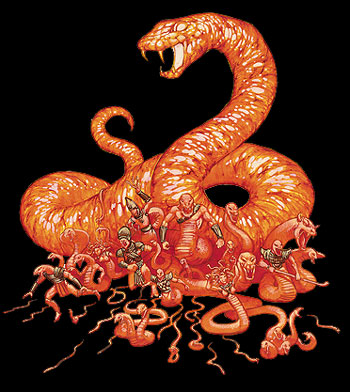 In addition to the above-described world's great cultures, the Dragon is found in mythology and minds of other nations. For example, in the ancient culture the Dragon was generally regarded as the embodiment of chaos, the antithesis of space and organized world. However, the Greco-Roman mythology also tells us that the Dragon was an indispensable companion of mighty Hercules, the winner of monsters. There are pictures, where the Dragon is harnessed to the chariot of Selene – the goddess of the Moon. The image of Dragon in Gnosticism (a number of late antique religious movements that used the motives of the Old Testament, early Christian teachings and eastern mythology), where it appears quite often, is also very interesting. So, here the Dragon is the symbol of all cyclic processes and depicted biting its own tail. This type of Dragon is called Urobonos. By the way, Urobonos was an emblem of the Order of Dragon, where the aforementioned “vampire” Vlad III Dracula was. In addition to the above-described world's great cultures, the Dragon is found in mythology and minds of other nations. For example, in the ancient culture the Dragon was generally regarded as the embodiment of chaos, the antithesis of space and organized world. However, the Greco-Roman mythology also tells us that the Dragon was an indispensable companion of mighty Hercules, the winner of monsters. There are pictures, where the Dragon is harnessed to the chariot of Selene – the goddess of the Moon. The image of Dragon in Gnosticism (a number of late antique religious movements that used the motives of the Old Testament, early Christian teachings and eastern mythology), where it appears quite often, is also very interesting. So, here the Dragon is the symbol of all cyclic processes and depicted biting its own tail. This type of Dragon is called Urobonos. By the way, Urobonos was an emblem of the Order of Dragon, where the aforementioned “vampire” Vlad III Dracula was.
The Dragons are the most popular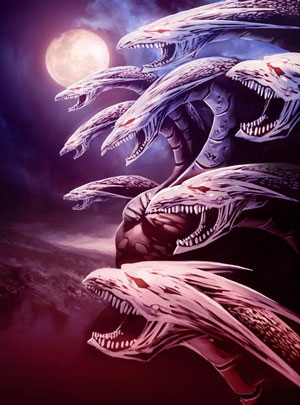 characters in the legends of Buddhism and Taoism that tell about deeds and lives of these creatures. The Dragons are snakes with wings, the image of which combined all animals and embodied two worlds - birds (upper world) and snakes (underworld). characters in the legends of Buddhism and Taoism that tell about deeds and lives of these creatures. The Dragons are snakes with wings, the image of which combined all animals and embodied two worlds - birds (upper world) and snakes (underworld).
The Dragon was considered to be an attribute of St. Clement of Metz (aprox. in 300), who was depicted winning the terrible monster. It is believed that St. Clement was the uncle of St. Clement I (the Pope). As legend goes, the Dragon, called Graulli, with its servants snakes lived in the local amphitheater, and its breath poisoned the whole district, so the people lived in captivity in their city. Once people turned to Christianity, St. Clement came to the lair of serpents and made the sign of cross in the amphitheater as soon as the Dragon attacked him. Thus, he tamed Graulli and ordered it and its servants to disappear to a place where animals and people didn’t live. Also, the Dragon was conquered by St. Merkurialis, the first bishop Frawley (Italy), St. Verana, St. Margaret of Antioch, St. Martha, St. Quirinus of Malmedy and other saints.
In Egyptian culture, the Dragon was the symbol of Osiris - the god of the dead and king of the underworld. In addition, Apep, a creature of ancient Egyptian mythology, a huge serpent, represented darkness and evil, he was an enemy of the God of the Sun Amon Ra. Every night, Amon Ra fought against Apep and won this fierce battle, as the rising of the Sun evidenced. By the way, in honor of Apep (in Greek - Apephis) a big asteroid 99942 Apephis was named, which is three times larger than the Tunguska meteorite.
For the Jewish people the Dragon is a symbol of desolation and devastation, it is the only inhabitant of deserts. In Hinduism the Dragon is an attribute of maidens-demigods Varuna and Soma, and Indra, according to legend, is the winner of Dragon. In ancient Iranian religion the Dragon is an attribute of deity Haoma, whose image is an exact match of Indian image of Soma. In  Vietnam, the Dragons are multi-valued symbols, which play an important role in Vietnamese art. The ancient Vietnamese people piously believed that their ancestor was a great Dragon-ruler Lac. The Japanese Dragon is, perhaps, the most significant and powerful of the world after the Chinese one. It has three toes on each paw that is its essential difference from the other Dragons. One of the most famous Japanese Dragons is Yamata-no Oroti – an eight-headed being that every year for seven consecutive years ate a daughter of the God of Earth Asinadzuti and his wife Tenadzuti. However, in the eighth year, a divine hero appeared from nowhere and after giving the Dragon to drink killed the man-eater, who apparently liked to drink. As a reward, the hero received the young girl he saved and the sword, with which he killed the drunken beast. Vietnam, the Dragons are multi-valued symbols, which play an important role in Vietnamese art. The ancient Vietnamese people piously believed that their ancestor was a great Dragon-ruler Lac. The Japanese Dragon is, perhaps, the most significant and powerful of the world after the Chinese one. It has three toes on each paw that is its essential difference from the other Dragons. One of the most famous Japanese Dragons is Yamata-no Oroti – an eight-headed being that every year for seven consecutive years ate a daughter of the God of Earth Asinadzuti and his wife Tenadzuti. However, in the eighth year, a divine hero appeared from nowhere and after giving the Dragon to drink killed the man-eater, who apparently liked to drink. As a reward, the hero received the young girl he saved and the sword, with which he killed the drunken beast.
In the mythology of Ancient America there are also numerous references to the Dragons, who were rattlesnakes with a long green feathers. In the Andes, the Dragon was depicted as a flying snake, the patron of travelers. Alchemists imagined the Dragon as a physical body or substance, and its sister is the soul or metallic mercury. The Dragon biting its own tail (Urobonos) was considered to be a symbol of infinity, a symbol of great work of alchemists. And in the alchemy the Dragon with wings is a female being, and the wingless beast - a male. In modern culture and society the Dragon is a favorite hero. Thus, it is one of the most famous heraldic character, for example, the red Dragon adorns the flag of Wales. I’ll note that in heraldry the Dragon is a more positive character, while the serpent is negative. You can distinguish these two entities by the number of paws: the Dragon has four and the snake - two. According to statistics, the outline and the image of Dragon are one of the most popular tattoos that today decorate the bodies of modern people. And everyone treats its Dragon differently, for each it means something special. Of course, the watch industry could not pass by such a great image, which has such a huge power reserve and influence. The watches with a picture of the Dragon are popular accessories among the fans of horlogerie especially that in 2012 a good reason to buy a watch with this legendary creature has appeared.
2012 — The year of Dragon in watchmaking
Dazzling beauty and originality of all these legends and stories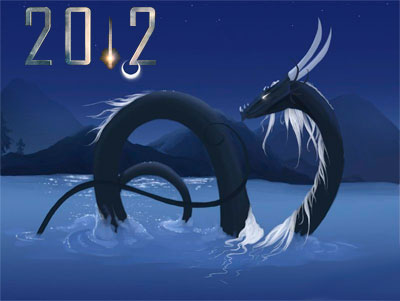 about Dragons that exist in different cultures around the world have drawn us away from the main thing, and we’ve forgotten that we have recently stepped into new 2012, and our Dragon rules this year, presenting many surprises. According to the Oriental horoscope, 2012 is the Year of Black Water Dragon, who rules the world under the auspices of masculine Yang. The inspired astrologers, by tradition, have rushed to give their recommendations and advice to people on the whole coming year. A famous person once said that astrology is an exact science, and all it says comes true. We only don’t know when, where and with whom exactly. Of course, it's just a joke, but if you still listen to the advice of many astrologers, this year you have no right to miss any opportunity to conquer new heights, and laziness and inaction can spoil everything, so you can achieve success this year only by means of active actions. The year of 2012 promises to be a year of changes, exciting, but at the same time, a difficult time. However, the difficulties should not be taken as a tragedy, but as tests, which will help you to open up new talents and qualities. about Dragons that exist in different cultures around the world have drawn us away from the main thing, and we’ve forgotten that we have recently stepped into new 2012, and our Dragon rules this year, presenting many surprises. According to the Oriental horoscope, 2012 is the Year of Black Water Dragon, who rules the world under the auspices of masculine Yang. The inspired astrologers, by tradition, have rushed to give their recommendations and advice to people on the whole coming year. A famous person once said that astrology is an exact science, and all it says comes true. We only don’t know when, where and with whom exactly. Of course, it's just a joke, but if you still listen to the advice of many astrologers, this year you have no right to miss any opportunity to conquer new heights, and laziness and inaction can spoil everything, so you can achieve success this year only by means of active actions. The year of 2012 promises to be a year of changes, exciting, but at the same time, a difficult time. However, the difficulties should not be taken as a tragedy, but as tests, which will help you to open up new talents and qualities.
People, who were born in the Year of Dragon, often achieve great heights in life, they just need to shine. The dragons are energetic, self-confident, proud, intelligent, faithful, resolute, and artistic. But often, such qualities of Dragons, as imperiousness, exactingness, rudeness and intolerance, make a difference. The world-known personalities, who were born under the sign of Dragon, are Che Guevara, Joan of Arc, Patrick Swayze, John Lennon, Tom Jones, and others.
As for the talented watchmakers, the attractive force of Dragon, which now shows off on the dials, movements and other elements of watches in all its splendor, could not escape their acute sight. Have you ever noticed that even the awesome look of Dragon, which would seem to discourage, by contrast, attracts and catches views? Personally, I do not have any doubt that this mythical creature has become almost real, and now it lives among us: in our thoughts, movies and cartoons, things and objects of art, which include watches. Wrist watches with pictures of Dragons, of course, can be worn on wrists by people, self-confident, leaders by nature, who are not afraid of difficulties and various life tests.
Bovet - sometimes it’s good to be two-faced
Of course, the owner of unique watch “Bovet 7-Days Tourbillon Reversed Hand-Fitting "Dragon & Phoenix", created specifically for the charity auction “Only Watch”, holds a unique object of art in his hand, unlike anything around the world. One of the main distinguishing characteristics of this model is that “Bovet 7-Days Tourbillon Reversed Hand-Fitting "Dragon & Phoenix" is not just a men's wristwatch. This time meter is transformed into a unique pocket watch of its kind or even a desk clock without any problems. This unique ability of the watch is possible thanks to the revolutionary case, known as Amadeo, which are provided in all watches from the collection “Fleurier” of the Swiss company “Bovet”. The brilliant idea of creating such case belongs to the owner of manufactory Pascal Raffy, who purchased the watch company Bovet in 2001. This time the case Amadeo has a diameter of 44 mm and is made of 18-karat rose gold. Due to the particular system, it gives the owner a unique opportunity to turn his watch into a pocket or desktop variants.

The matchless men’s watch from Bovet is equipped with the movement 13VM07AI of manual winding, which is characterized by a tourbillon. The men's wristwatch “Bovet 7-Days Tourbillon Reversed Hand-Fitting "Dragon & Phoenix" has two dials or two "faces" that are located on both sides of golden case. The balance frequency is 28,800 vibrations per hour (4 Hz). The duality of model and the history of watch brand “Bovet” identified the main theme of the time meter. The Chinese motifs and mythological symbols have become the basic idea of decorating two luxury dials.
The dial, located on the front case, is decorated with an intricate picture of magnificent Chinese Dragon, and the back dial presents to our attention a "portrait" of Phoenix. The attentive reader will, of course, remember that these two animals in Chinese mythology are inextricably linked to each other, as two principles: the female Yin (Phoenix) and the male Yang (dragon), which embody the harmony. The Dragon is not engraved only on the dial, its powerful figure stretches on the surface of bezel and side parts of the case. The first dial, which "belongs" to the Dragon, is provided with blued hour and minute hands and tourbillon at "3" hours. At "9" hours there is a miniature power reserve indicator, by the way, this watch has a truly enormous reserve - about 7 days. On the back case the tourbillon’s carriage with a small second hand and two blued hands is also seen. The second dial is decorated with an engraving of Phoenix, the image of which is slightly smaller than the Dragon. All complicated engravings were made exclusively by hand. Thus, only the decoration of the case took the watchmakers about 300 hours of painstaking work. It only remains to add that the men’s watch “Bovet 7-Days Tourbillon Reversed Hand-Fitting "Dragon & Phoenix" is one of the most striking examples of modern "dragonomania" or the cult of Dragon, which is incredibly "revives" in front of the fascinated public.
.jpg) 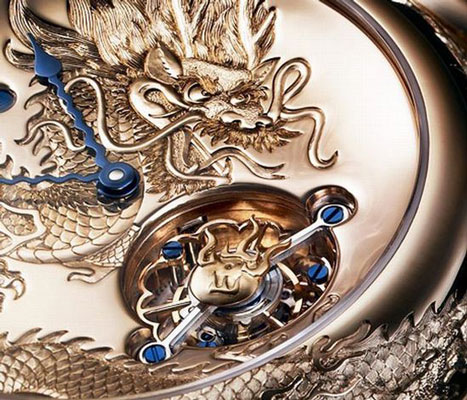
Chinese Dragons by Vacheron Constantin
The great Swiss watchmaker “Vacheron Constantin” also felt the attractive force and extraordinary power of Chinese Dragons. So, in 2009 in honor of the opening of its new boutique in Hong Kong, the manufactory introduced three models of men's watches with images of Dragons, devoted to China. Each of "Three Dragons" by Vacheron Constantin was released in a strictly limited quantity - only 9 pieces. You can buy watches with the Chinese Dragons only in boutiques in Hong Kong, Geneva and Moscow.
So, the dials of these models are adorned with the images of Dragons - Chinese symbols of prosperity and strength, both spiritual and physical. The guilloche, decorating the dials of three models “Vacheron Constantin Metiers D’art Les Dragons”, is distinguished by its unique beauty and complexity of execution. All Dragons are exclusively hand-made by the professionals of Vacheron Constantin, combining two different techniques of guilloche. The craftsmen achieved unique asymmetric patterns, which are radically different from the elements of watch decor, created by the company earlier. As a result, the design of dials is a combination of unusual lines and unique metalized details of different colors. These designs go far beyond the usual understanding of guilloching as an art of abstract decoration. In this case, the technique of dial decoration has reached the level of so-called figurative art, where all objects are depicted in the most realistic images, a striking resemblance to the real figures is kept in them. Undoubtedly, the "dragon" figurative painting from Vacheron Constantin is one of the best works in watchmaking, as well as in Chinese symbolism.
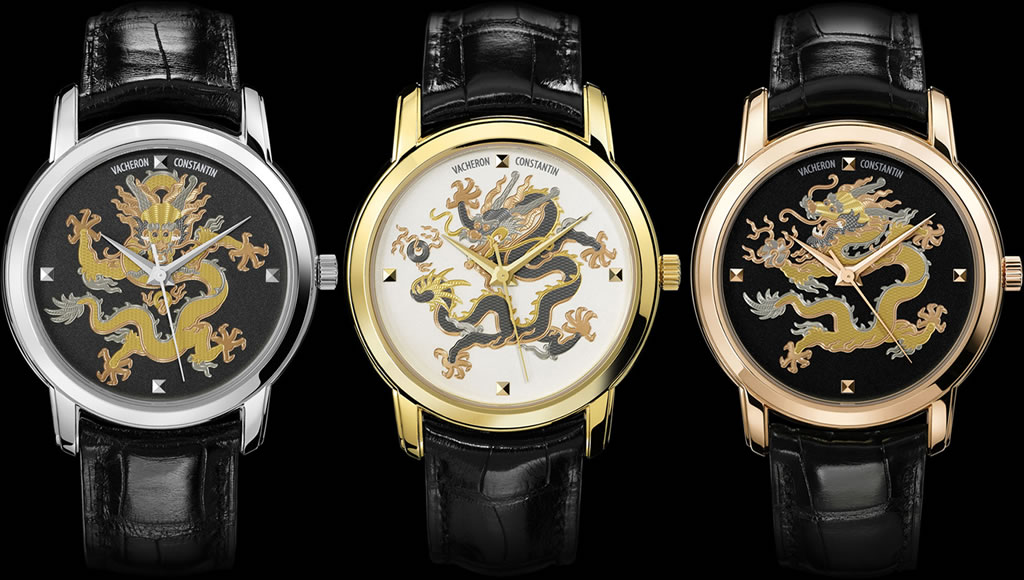
The differences of the three models “Vacheron Constantin Metiers Dart Les Dragons” consist in the materials of cases, colors of dials and shapes of Dragons. The men's wristwatch with a 42-mm case of 18-carat yellow gold (ref. 86090/000J-9499) has a white dial and the Dragon of contrasting dark gray color. On the black dial of rose gold model (ref. 86090/000R-9498) the yellow Chinese Dragon is located, and the Vacheron Constantin watch of white gold (ref. 86090/000G-9497) has a dark gray dial and yellow Dragon. The men's watches are equipped with self-winding caliber 2460 SC on 27 stones, the functions: hours, minutes and seconds (three central hands and 4 gold pyramids as hour markers.) The power reserve is approximately 40 hours, the balance frequency - 28,800 vibrations per hour. The water resistance of models - 30 meters. The dial and the back case are closed with transparent sapphire crystal. The happy owners of "Dragons" from the company “Vacheron Constantin” can wear their watches with leather straps of black color with original clasps of Vacheron Constantin in the form of half Maltese cross.
Dragons of Russian miniatures’ style by Corum
.jpg) The Swiss watch company “Corum”, fascinated by the "Dragon" theme long before the Year of Dragon 2012, produced an amazing men's wristwatch, the dial of which "was influenced by" the almighty power of the incredible mythical creature, at the beginning of the 2000s. In an interview, the former owner of the watch company “Corum”, unique Severin Wunderman, who died in 2008 at the age of 69, admitted that, creating a watch with the theme of the devil (Corum Bubble Lucifer) and the motif of the Eastern Dragons (Corum Classical Heure Sautante), he did not predicting the end of the world, as many watch commentators and critics suggested. Mr. Wunderman believed that the "dragon" motif in wristwatches, no doubt, would attract a huge number of buyers and connoisseurs of the beautiful and mysterious. As we can see, the watchmaker was not mistaken. The Swiss watch company “Corum”, fascinated by the "Dragon" theme long before the Year of Dragon 2012, produced an amazing men's wristwatch, the dial of which "was influenced by" the almighty power of the incredible mythical creature, at the beginning of the 2000s. In an interview, the former owner of the watch company “Corum”, unique Severin Wunderman, who died in 2008 at the age of 69, admitted that, creating a watch with the theme of the devil (Corum Bubble Lucifer) and the motif of the Eastern Dragons (Corum Classical Heure Sautante), he did not predicting the end of the world, as many watch commentators and critics suggested. Mr. Wunderman believed that the "dragon" motif in wristwatches, no doubt, would attract a huge number of buyers and connoisseurs of the beautiful and mysterious. As we can see, the watchmaker was not mistaken.
Severin Wunderman personally worked on the design of “Corum Classical Heure Sautante Dragon”, as well as on many other collections of Corum. It should be said that this watch has all the features of classic time meter, but at the same time has their own special unique characteristics that allow to refer the model to exclusive products of watchmaking. The Dragon motif on the bright red dial is a symbol of imperial power in ancient China. The Chinese Dragons (by two on each watch model), showing off on the lacquered dial, are hand-written by means of the ancient technique of Russian miniatures. The watchmakers, who worked on the decoration of watch, used a super-powerful magnifying glass and incredibly thin brushes - of human-hair thickness. on the design of “Corum Classical Heure Sautante Dragon”, as well as on many other collections of Corum. It should be said that this watch has all the features of classic time meter, but at the same time has their own special unique characteristics that allow to refer the model to exclusive products of watchmaking. The Dragon motif on the bright red dial is a symbol of imperial power in ancient China. The Chinese Dragons (by two on each watch model), showing off on the lacquered dial, are hand-written by means of the ancient technique of Russian miniatures. The watchmakers, who worked on the decoration of watch, used a super-powerful magnifying glass and incredibly thin brushes - of human-hair thickness.
In addition to exquisite hand work, this men's watch is characterized by outstanding mechanics, a "zest" of which became the so-called "jumping" hour. Thus, a single center minute hand of the watch makes a full circle, at the time when the current hour is displayed in a large aperture in the position of "12 o'clock". The small second hand on the additional dial is placed at "6" hours. The men's watch “Corum Classical Heure Sautante Dragon” offers fans of watchmaking art a unique system of time indication, which in some ways is a special unique "metamorphosis" in the watch industry, which indicates a high level of Haute Horlogerie.
The men's wristwatches with Dragons from the company “Corum” were issued in yellow and white gold of 18 carats and are incrusted with 69 sparkling diamonds weighing 2.14 carats. The series are limited totally by 50 pieces, indicating a high exclusivity and complexity of watches “Corum Classical Heure Sautante Dragon”. The diameter of gold case is 42 mm, the thickness - 12 mm, the water resistance - up to 50 meters.
The life of "Dragon" is supported by the movement CO 154.HS of manual winding, operating on 20 stones. The balance frequency is 21,600 vibrations per hour that provides a power reserve of up to 42 hours at full winding. The men's watch “Corum Classical Heure Sautante Dragon” is equipped with a strap made of alligator leather with folding clasp of 18 carat yellow or white gold.
Returning to the words of great watchmaker Severin Wunderman, it is worth noting that, despite such audacious and "transcendental" theme of wristwatches, the master had a deep faith in God, but almost never attended the church. "People say they go to church as if to talk with God. In fact, they go to beg him anything. And I ask for nothing, I have everything "- said the watchmaker. You may believe or not in the power of signs and symbols, but you can’t but believe in the beauty of hand work, demonstrated by the watchmakers of Corum.
Chronoswiss Edition Zeitzeichen VII Dragon – Dragon’s “skeleton”
In 2009, the watch company “Chronoswiss” in collaboration with talented craftsman Jochen Benzinger introduced the world a collection of skeleton watches, called Zeitzeichen, which translates from German as "moments of time". This is men's watches for connoisseurs of horology, who prefer hand work performed at the highest level. While the world market is full of "brutal" models in hi-tech style, Chronoswiss remains almost the only manufactory, which pays all attention to the aesthetics and beauty of its time meters. The collection “Zeitzeichen” includes three models of wristwatches-skeletons, one of which contains a unique image of Dragon. This if the men's watch “Chronoswiss Edition Zeitzeichen VII Dragon”. And the main difficulty and originality of this watch is that the Dragon sits on a fully skeletonized dial, through which a "semi-transparent" movement-skeleton is seen. One look at this watch is enough to understand: "The Dragon" from Chronoswiss is a standard of skeleton creation art.
The men's wristwatch “Chronoswiss Edition Zeitzeichen VII Dragon” is released in a limited quantity - only 33 copies. The watch case with dimensions of 44 mm x 10.8 mm is made of 18-carat red or white gold. The skeletonized dial is covered with a flat sapphire crystal with anti-reflective coating, the back case is made of the same glass. The bulb-crown gives a special charm and unique fascination of classic and luxury to the image of the model.
9.jpg) |
 |
A skeletonized "heart" is "beating" within the watch - a modified version of the Swiss movement ETA 6498-1. The caliber operates on 17 stones, the balance oscillates at the frequency of 18,000 vibrations per hour. The movement plate, bridges and balance regulator were skillfully engraved and skeletonized by hand. The caliber is equipped with anti-shock system “Incablock”, protective system “Glycydur”, flat balance springs “Nivarox-1”, ideally polished pallet forks, escapement and screws.
On the skeletonized dial the Dragon sits, and around it the hour and minute hands rotate. The additional second counter, which is almost lost on the general background of skeleton dial, is located at "6" hours. The men's wristwatch “Chronoswiss Edition Zeitzeichen VII Dragon” is offered to wear with a dark brown leather strap with folding clasp made of 18-carat red or white gold. The majestic figure of Dragon is a quaint movement bridge, made of sterling silver. The men's skeleton-watch “Chronoswiss Edition Zeitzeichen VII Dragon” can be referred to one of the most unique models that whirled in the popularity of modern "dragonomania."
Gebson Sky & Earth Ciel Royal Dragon - a standard of enamel art
Founded in 2007, a young Swiss company “Gebson”, irresistibly attracted by the mysterious "dragon" world, released the men's wristwatch “Gebson Sky & Earth Ciel Royal Dragon” (reference CT.S01SDC 13), which can be safely put in a line with the products of the best-known luxury Swiss brands, in 2009. The philosophy of Gebson can be characterized as follows: "between high art and complex mechanics." The watches of this manufactory absorbed the artistry of masters, cultural symbolism and historical traditions of watchmaking. When creating its collections, Gebson draws inspiration from Chinese culture, which history is over 5000 years old. The use of unique enameling techniques and the best ultra-precise movements made the watches by Gebson attractive for all fans of chorology. The works of this manufactory really deserves the highest praise, as the young company “Gebson” competes with the brands that have already earned respect at the world market. For example, the watchmaker “Angular Momentum”, which, like Gebson, uses special decorative techniques and unique design of time meters, is a serious competitor.
.jpg) |
.jpg) |
A unique feature of the watch “Gebson Sky & Earth Ciel Royal Dragon” is the absence of any inscriptions on the dial, including the name of the manufacturer. This is a pretty bold step for the company Gebson risked to remain "unidentified" among the huge variety of watches at the world market. Of course, that did not happen, and the men's wristwatch “Gebson Sky & Earth Ciel Royal Dragon” attracted the attention of all connoisseurs of horology and fans of Chinese symbols. The men's wristwatch “Gebson Sky & Earth Ciel Royal Dragon” belongs to the collection “Sky & Earth”, which also includes time meters with images of tigers, symbolizing strength and power. And for the beautiful half of humanity the Gebson company prepared a special surprise – the women's wristwatch with a picture of Phoenix, Chinese symbol of Yin.
So, the Chinese Dragon of golden color on is depicted on the bright red dial of “Gebson Sky & Earth Ciel Royal Dragon”. The watchmakers, who worked on the masterpiece, used two enameling techniques at once: traditional champlevé and Chinese miniature painting, by which the aforementioned company “Bovet” is also "attracted". Champlevé is a technique, which is based on engraving a hollow and then filling it with enamel of various colors and shades. Due to the high complexity of execution, the wristwatch with enamel Dragon from Gebson was released in a strictly limited edition - consisting of 8 copies. The watch dial has three central hands, responsible for counting hours, minutes and seconds, and date aperture at "3 o'clock". The round date aperture is enclosed in a "flame" that the handmade golden Dragon, decorated with yellow sapphires, “shoots out” of its mouth. The watch case is made of 18-karat yellow gold, and the bezel is encrusted with diamonds and semiprecious stones of red color, replacing the hour indexes. Inside the "Dragon" there is an accurate Swiss movement with automatic winding. This model is offered by the company with a leather strap with a buckle of 18-carat yellow gold.
.jpg) |
(1).jpg) |
Also the manufactory “Gebson” released another version of the Chinese "Dragon" - the men's wristwatch “Gebson Sky & Earth Ciel Royal Dragon” (reference CT.S01.DC 22), made of 18-karat white gold. The bezel of this model is encrusted with diamonds and blue sapphires. On the blue dial a silver-colored figure of Dragon, also adorned with diamonds, is situated. By the way, the company “Gebson” didn’t stop creating Chinese "Dragons" on two aforementioned models. A little later the manufactory expanded the collection “Sky & Earth”, introducing two models of wristwatches with pictures of Dragons, made by hand with two techniques of enameling. At this time the Dragons "hold" a circle in the center of the dial in their clawed paws, which symbolizes the Sun. These masterpieces are also made of 18-carat white (reference CT.S01.DJ 22) or yellow (reference CT.S01.DJ 13) gold, and the bezels and dials are encrusted with diamonds and sapphires.
Mokume Gane Dragons by Kees Engelbarts
 The Swiss company “Kees Engelbarts” is an amazing manufactory, founded by Kees Engelbarts, an attractive man and talented artist from Netherlands. This company is one of the watch manufacturers that win all the fans of Haute Horlogerie at first sight. Kees Engelbarts creates unique men's watches, characterized by exclusive hand finishing, all models are available in strictly limited quantities. One of the favorite themes of Dutch artist is Dragons, which are represented at almost all works of genius craftsman. They are both images of Eastern and European Dragons. In addition to the Dragons, the watches of Kees Engelbarts are decorated with figures of creatures, such as unicorns, horses and tigers. According to Kees Engelbartsa, the Dragons, as the most influential and powerful creatures, form the core of the ancient oriental culture. Hence the numerous "dragon" watches from Kees Engelbarts. By the way, to emphasize the spirit of antiquity and greatness, the master equips his watches with NOS movements (“new old stock”). They are retro calibers, such as A.Schield of 50s, 60s and 70s, but all the movements are improved by the watchmakers and artfully decorated by the best engravers, so they can be safely referred to the brilliant masterpieces of modern mechanics. Absolutely all watches of Kees Engelbarts are equipped with transparent sapphire glasses from both front and back sides that allow you to admire the splendor of hand-engraved movements. The Swiss company “Kees Engelbarts” is an amazing manufactory, founded by Kees Engelbarts, an attractive man and talented artist from Netherlands. This company is one of the watch manufacturers that win all the fans of Haute Horlogerie at first sight. Kees Engelbarts creates unique men's watches, characterized by exclusive hand finishing, all models are available in strictly limited quantities. One of the favorite themes of Dutch artist is Dragons, which are represented at almost all works of genius craftsman. They are both images of Eastern and European Dragons. In addition to the Dragons, the watches of Kees Engelbarts are decorated with figures of creatures, such as unicorns, horses and tigers. According to Kees Engelbartsa, the Dragons, as the most influential and powerful creatures, form the core of the ancient oriental culture. Hence the numerous "dragon" watches from Kees Engelbarts. By the way, to emphasize the spirit of antiquity and greatness, the master equips his watches with NOS movements (“new old stock”). They are retro calibers, such as A.Schield of 50s, 60s and 70s, but all the movements are improved by the watchmakers and artfully decorated by the best engravers, so they can be safely referred to the brilliant masterpieces of modern mechanics. Absolutely all watches of Kees Engelbarts are equipped with transparent sapphire glasses from both front and back sides that allow you to admire the splendor of hand-engraved movements.
The main feature of all watches by Kees Engelbarts is the use of special technique, so-called Mokume Gane. Mokume Gane in Japanese means "metal pine wood." This technique is based on the use of a composite material consisting of dissimilar metals of various colors that make up a fancy decorative pattern, similar to the texture of the wood. In medieval Japan, that technique was used for decoration of weapons, the so-called katana (Japanese long sword). Today the art of Mokume is widely used in jewelry, and its essence lies in the fact that some sheets of jewelry metal (such as yellow and white gold, platinum, palladium) are folded in layers, they are heated so that the metals are "baked" to each other, forming an indissoluble compound.
To understand the beauty of Mokume Gane, you should pay attention to the following series of watch models, presented by Kees Engelbarts, each of which is released in a single copy. For example, let’s look at the men's wristwatch “Kees Engelbarts Mokume Gane Dragon” ref. 0267, made of platinum. A transparent sapphire crystal of convex shape, installed on the front side of 36-millimeter case, opens the figure of Chinese Dragon, made by the technique of Mokume of white gold and silver, and engraved by hand. The transparent back case of sapphire glass opens the automatic skeleton movement Piguet 71 on 35 stones. The power reserve - 48 hours, the balance frequency - 18,000 vibrations per hour. The watch is supplied with a leather strap with platinum clasp.
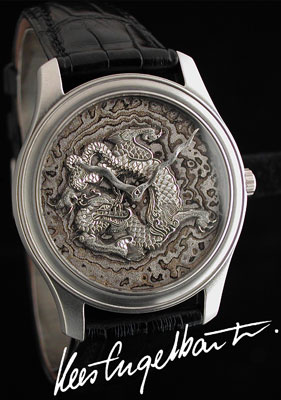 |
 |
Another masterpiece with Dragon is the men's wristwatch “Kees Engelbarts Mokume Gane Dragon” ref. 0368, characterized by a 36-millimeter case of yellow gold and skeletonized movement with 25 stones and 46-hour power reserve. The balance frequency - 19,800 vibrations per hour. The Chinese Dragon on the dial is made of yellow gold and silver. The "Dragon" is fixed on the wrist by a leather strap and buckle of yellow gold.
The Swiss watch company “Kees Engelbarts” introduced to the attention of its fans another 4 models of wrist watches with Dragons on the dials, "driven" by the abovementioned automatic movement. These are the men's watches “Kees Engelbarts Mokume Gane Dragon” ref. 0367 of white gold (the Dragon is made of white gold and silver), “Kees Engelbarts Mokume Gane Dragon” ref. 0371 in rose gold (the Dragon is made of pink gold and syakudo - an alloy of 4% gold and 96% copper, typically having a blue patina), “Kees Engelbarts Mokume Gane Dragon” ref. 0369 in rose gold (the Dragon is made of pink gold and syakudo) and “Kees Engelbarts Mokume Gane Dragon” ref. 0469 in white gold (the Dragon is made of white gold and silver). The Dragons sitting on the dials of all models are completely different: they have different poses, shapes, each of them has its own unique expression of eyes and a very special facial expressions.
The men's wristwatch “Kees Engelbarts Mokume Gane Dragon” ref. 0468, which has a case of 42-mm diameter, made of 950 platinum, deserves a special attention. The abovementioned skeleton caliber Piguet 71 is seen through both transparent back case and completely skeletonized dial, on which the Dragon of white gold and silver is located.
The men's watches “Kees Engelbarts Mokume Gane Dragon 1 Jumping Hours” ref. 0567 and “Kees Engelbarts Jumping Hours Dragon” ref. 0567, which stand out against other works of the Dutch master with the so-called "jumping" hour, are not less unique. The dials of these models are lack of hands, and the hours and minutes are indicated by a large aperture at "9" hours. The diameter of white gold cases is 42 mm, the thickness - 11 mm. The vintage self-winding movement of 1970's AS 2072 at 17 stones operates inside the white gold case, the balance frequency is 21,600 vibrations per hour. The power reserve is 42 hours. The Chinese Dragons are made by hand with the use of Mokume Gane of white gold and silver. The buckle on leather strap of 18-carat white gold is also decorated in the style of Mokume Gane.
The men's wristwatch “Kees Engelbarts Flying Dragon” ref. 0967 is of great interest to the fans of big time meters, which number is growing every year. The case of this model is 48 mm in diameter, its thickness - 12 mm. The Swiss watch “Kees Engelbarts Flying Dragon” ref. 0967 is made by hand in a single copy of 18-carat red gold and provided with the vintage movement “Vintage Record Watch Co. Geneva”, working on 17 stones at a frequency of 18,000 vibrations per hour. The manual winding caliber has a power reserve of 38 hours. A flying Chinese Dragon, the figure of which is made and decorated by hand from composite materials - red gold and silver-plated red gold, is depicted on the dial.
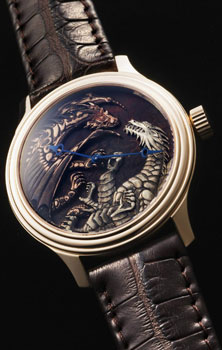 |
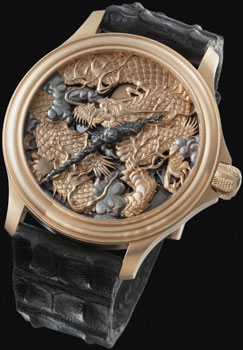 |
The men's wristwatch “Kees Engelbarts Fighting Dragons” ref. 0568 is decorated with images of two Dragons at once, which this time have a more "European" look. These are winged mythical creatures, which are depicted in the midst of a brutal fight. At creation of dial the masters used two types of Mokume Gane technique: the first Dragon is made of white gold and silver, and the second - of red and gold syakudo. The 39-millimeter watch case is made of pink gold. Such an abundance of combined precious metals, presented in a single watch model, indicates a high value and uniqueness of this time meter from both aesthetic and technical points of view. The fighting Dragons “live” at the expense of skeletonized self-winding movement on 35 stones with 48-hour power reserve. The balance frequency - 18,800 vibrations per hour.
On the dial of amazing “Kees Engelbarts Mokume Gane Tiger Dragon” ref. 0472 two strong representatives of Chinese Mythology - Dragon and Tiger – are located at once. In this watch every detail is admirable: the sides of 42-millimeter case of 18-carat white gold are adorned with 54 baguette-cut diamonds, the gold buckle is also decorated with black stones, and the figures of animals are made of white gold and silver. An automatic skeletonized movement with 35 stones and frequency of 18,000 vibrations per hour is ticking inside the watch.
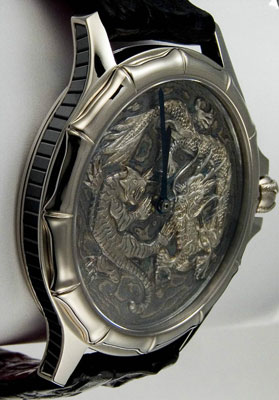 |
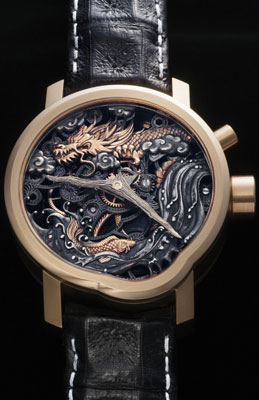 |
Another creation of Kees Engelbarts, which will be discussed.jpg) below, is probably the most prominent work of art and unique masterpiece of watch mechanics. This is the men's wrist watch “Cornelius & Cie The Dragon Gate Legend” ref.0667, which was designed by the company “Cornelius & Cie” – “the brainchild" of genius watchmaker Kees Engelbarts. This watch "tells" an incredibly beautiful legend. On the partially skeletonized dial, made of pure gold, and silver-plated and oxidized gold, the Dragon and Carp fish are depicted. According to ancient Chinese legend, the Carp, overcoming all obstacles and difficulties, sailed through a giant waterfall, then turned into a Dragon, which symbolizes strength and power. In Chinese mythology the top of the waterfall, through which the Carp "jumped", is known as "The Dragon Gate". This legend is now used as an allegory, it means all the difficulties and sufferings, which a person must pass to earn success and achieve harmony. The 49-millimeter case of "legend"- watch has a rather interesting "wrong" shape and is made of 18-karat rose gold. The unique retro-movement AS 690 (of about 1935) is engraved by hand, it runs on 17 stones, the frequency - 18,800 vibrations per hour. The power reserve is huge - as many as 8 days. This men's wrist watch with the Dragon is radically different from all the "dragon" models created previously, as it has a deeper meaning and an invincible force that embodies unconquerable spirit of human perseverance and diligence. below, is probably the most prominent work of art and unique masterpiece of watch mechanics. This is the men's wrist watch “Cornelius & Cie The Dragon Gate Legend” ref.0667, which was designed by the company “Cornelius & Cie” – “the brainchild" of genius watchmaker Kees Engelbarts. This watch "tells" an incredibly beautiful legend. On the partially skeletonized dial, made of pure gold, and silver-plated and oxidized gold, the Dragon and Carp fish are depicted. According to ancient Chinese legend, the Carp, overcoming all obstacles and difficulties, sailed through a giant waterfall, then turned into a Dragon, which symbolizes strength and power. In Chinese mythology the top of the waterfall, through which the Carp "jumped", is known as "The Dragon Gate". This legend is now used as an allegory, it means all the difficulties and sufferings, which a person must pass to earn success and achieve harmony. The 49-millimeter case of "legend"- watch has a rather interesting "wrong" shape and is made of 18-karat rose gold. The unique retro-movement AS 690 (of about 1935) is engraved by hand, it runs on 17 stones, the frequency - 18,800 vibrations per hour. The power reserve is huge - as many as 8 days. This men's wrist watch with the Dragon is radically different from all the "dragon" models created previously, as it has a deeper meaning and an invincible force that embodies unconquerable spirit of human perseverance and diligence.
By the way, I almost forgot. When I first saw the watches by that master, I paid a special attention to the hands of some models. For example, the men's watches “The Dragon Gate Legend” and “Flying Dragon” ref. 0967. The hands are as if made of wood, but in fact such an effect was achieved through the technique Mokume Gane, actively used by the author.
All the above-described watches, bearing a dragon symbolism, are only a small part of a huge number of similar models on the global watch market. As it turned out, the mythology along with the ancient Eastern symbolism is a fertile ground for activity of not only researchers and historians, but also the talented watchmakers, who draw inspiration from almost all spheres of human life. It is usually quite difficult to buy watches with Dragons, since all models are available in strictly limited quantities due to the high complexity of their execution. For example, the enamel "Dragons" or "Dragons" made of precious metals, and fire-breathing creatures, "painted" by hands of the best miniature artists, require tremendous efforts. Of course, the "strength" of watchmakers’ craftsmanship, who risked to create Dragons, must fully comply with the power of this amazing mythical creature, ready to guard and protect us throughout 2012.
|


